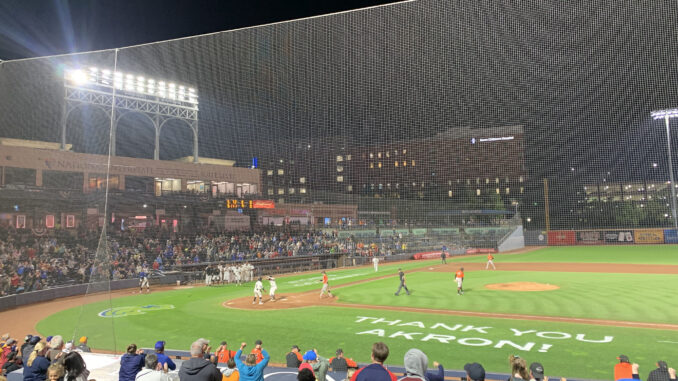
Luke Henne | Sports Editor
Sept. 30, 2021
On Friday evening, Cleveland Indians prospect Bo Naylor recorded a walk-off single to help the Akron RubberDucks erase a five-run, eighth-inning deficit en route to defeating the Bowie Baysox and winning the 2021 AA Northeast League title.
Nearly 3,500 spectators (myself included) gathered at Canal Park in Akron, Ohio, to watch the come-from-behind victory. The game was a celebration of the entire season, a season that cities with Minor League Baseball teams so desperately needed.
After the entire 2020 MiLB season was canceled as a result of the Covid-19 pandemic, smaller-market cities across the country suffered economic turmoil.
Forty of the 160 cities with MiLB teams lost their affiliation with Major League Baseball teams and were forced to either join non-affiliated leagues or cease operations entirely.
If a team in a city the size of Akron or Altoona, Pa., no longer possesses the designation of being affiliated with a Major League Baseball club, they’re bound to endure hardships.
These cities — determined to market their MiLB teams as a primary source of entertainment and tourism — watched as their stadium gates remained locked for an entire season.
Hunter Sosenheimer is a broadcaster and videographer for Summit City Sports, a company based in Fort Wayne, Ind.
Sosenheimer has grown up as a fan of the Fort Wayne TinCaps (formerly the Fort Wayne Wizards), an MiLB team based in the city since 1999. He affirmed the importance of the TinCaps franchise to the overall recognition of the city.
“Having a minor league team in your city just creates joy,” Sosenheimer said. “The TinCaps are a summer go-to, with them being rated among the top things to do in the summer in Fort Wayne. Us not having them in the city would make for a boring summer.”
Sosenheimer raises a good point. These cities would struggle immensely without MiLB teams.
What would have been a better entertainment alternative for those in Akron on Friday evening? Go to a local high school football game? Eat at a local diner?
These cities so desperately crave MiLB teams. Imagine how much more likely a novice fan is to attend a game if they know that they’re going to watch the top prospects for an MLB team like the New York Yankees or Boston Red Sox.
“You see guys like Fernando Tatis Jr. and Corey Kluber play in Fort Wayne and then get to see the impact they’re making in the big leagues.” Sosenheimer said. “It’s super cool to see those guys on TV now and say you watched them once play in your hometown.”
Teams in MiLB cities also possess the unique ability to name their franchise by using historical aspects of the city or region. The RubberDucks’ name pays homage to the city’s key role in the rubber industry. The Altoona Curve franchise draws its name from the Horseshoe Curve, a historical railroad curve that sits just outside of the city. The TinCaps’ name is a tribute to Johnny Appleseed, who spent the final years of his life in Fort Wayne.
Are there less-than-ideal aspects associated with games in MiLB stadiums? Absolutely.
I don’t think a single fan would lose sleep at night if every strikeout or foul ball at Canal Park weren’t sponsored by Cleveland Clinic Akron General or Luigi’s Pizza (local establishments), respectively.
However, in order for these franchises to survive, this is an essential course of action.
While the city needs an MiLB team to boost its local economy, the team needs to market itself and partner with local advertisers whenever and wherever possible.
Fans from Akron and abroad remained in the stadium for nearly an hour after Naylor’s game-winning hit to watch a fireworks show, while also watching their team celebrate a championship. They deserved every single minute of that celebration.
Cities like Akron and Fort Wayne don’t get noticed all that often. They’re not “major-league” cities. More often than not, they’re a means to an end in the baseball world.
After capacity limitations were officially lifted in cities like Fort Wayne during the 2021 season, people like Sosenheimer could finally breathe a sigh of relief.
“As the season went on, more and more fans were able to come out to games,” Sosenheimer said. “You could just tell it meant a lot to the full-time staff. That’s what it’s all about.”
These cities have withstood the economic uncertainty induced by Covid-19, and they once again have the chance to reap the benefits of fielding an MiLB team in their particular city.
After last season, the benefits need to be reaped as often as possible. If not, a city might be at risk of losing its team altogether.

